From rolled down windows to complex multi-zone HVAC Systems, the Air Conditioning in automobiles has come a long way. A typical air conditioning system in a modern car consists of several components such as Compressor, Condenser, Evaporator, Refrigerant etc. With such complex system, the maintenance also becomes critical and one important factor to keep track off is the pressure of the refrigerant.
In this article, we will dig a little bit deeper into Car AC Refrigerant, a typical Car AC Pressure Chart for a commonly used refrigerant i.e., the R134a and also some troubleshooting tips with respect to the AC system pressure.
Outline
ToggleHow Does Car AC Work?
Let us first see a very basic overview of how the air conditioning system in your car works. The process of removing heat from an area or location is called as Refrigeration. The unwanted heat is mechanically transferred to an external area where the heat is unobjectionable. Refrigerators and Air Conditioners are the perfect examples of this system.
A special fluid called Refrigerant is used in refrigerators and air conditioners that helps in transfer of heat by continuously cycling between high high-pressure liquid state and a low-pressure gas state. During this process, it absorbs heat and humidity from the car’s cabin and provides with cool and dry air.
All the components i.e., the compressor, condenser, accumulator (or receiver drier) and evaporator work in harmony to give you with cool air.
It is clear that the main component that helps in cooling your cabin is the refrigerant. At a low AC pressure and temperature, the refrigerant absorbs heat. During this phase, the refrigerant is converted from liquid to gas. To expel all the heat absorbed by the refrigerant, it is condensed from gas to liquid at high temperature and pressure.
It is important for the refrigerant to have certain properties such as:
- It should not be explosive or flammable
- It should have a low boiling point
- It should be non-corrosive to metals and must mix well with oils
- It shouldn’t be hazardous and must be safe and non-toxic
- It should have a large latent heat value
- It should be easy to liquify or vaporize and also moderate its pressure and temperature
There are many other properties that a refrigerant must have (there are some requirements even at the molecular level). Based on these and several other properties, some of the popular and industry approved refrigerants are:
- R-12
- R-134a
- Freon (Freon-11, Freon-12, Freon-13, Freon-21, Freon-22, Freon-113, etc.)
- Freeze-12
- GHG-HP
- Hot Shot
- Ikon-12
- R-406A
R134a Refrigerant
Earlier, the R-12 (also sold under the brand name Freon-12) was used as the main refrigerant in automobiles and household refrigeration. But due to its damaging effect on ozone, it has been banned in phases starting from 1994.
Since then, the R134a refrigerant became the industry standard in automotive ACs and other refrigeration and freezing applications. The thermodynamic properties of R134a are very similar to that of R-12 but it has significantly less impact on the depletion of ozone layer.
At atmospheric pressure, the R134a has a boiling point of -26.8oC and at 10psi pressure, its boiling point rises to -10.6oC. If R134a is released into a room at atmospheric pressure and room temperature, it would instantly turn into gas.
The temperature and pressure of the refrigerant have a direct relationship. If the pressure of the refrigerant (R134a) is 35psi or 241kPa, then its temperature will be 4.4oC. So, it is clear that temperature and pressure play an important role in the condensation and expansion of R134a.
R-134A Low Side and High Side Pressure
Before looking at the AC R134a Pressure Chart, we will try to understand why measuring and monitoring pressure is important in a car’s air conditioning system.
In an automotive AC System, a pressurized refrigerant continuously changes from liquid to gas and gas to liquid in a closed loop. The pressure of the refrigerant directly correlates with the temperature.
Based on the pressure of the refrigerant at any particular point in the loop, the whole system can be divided into High side ac pressure and Low side ac pressure.
The compressor receives the low-pressure gas from the evaporator. Compressor compresses this low-pressure refrigerant gas to high pressure gas (the temperature also increases). As this is the starting point of the high-pressure refrigerant gas, the High-Pressure measuring point is located after the compressor.
This high-pressure gas is then transferred to the condenser. The radiator fan near the condenser blows cool air onto the condenser and as a result, the high-pressure gas is converted into high pressure liquid, when it leaves the condenser. Also, the refrigerant releases heat here which it absorbed at the evaporator.
The high-pressure liquid then flows through the receiver / dryer, which filters out the moisture in the refrigerant. Filtered high-pressure liquid then passes through a thermal expansion valve. The high-pressure liquid will expand and convert to a low-pressure liquid at the expansion valve. The low-pressure liquid then flows to the evaporator and the refrigerant starts to boil and converts to low pressure gas.
This low-pressure gas absorbs the heat from the cabin and is then sent to the compressor and the cycle starts again. As this is the exit point of the low-pressure refrigerant gas, the Low-Pressure measuring point is located after the evaporator.
R-134A AC Pressure Chart
To check the low side pressure and high side pressure of the refrigerant, a special testing device which contains two pressure gauges (one for low side and one for high side) connected to a manifold assembly. The high side pressure gauge and its connecting pipe are usually colored Red while the low side pressure gauge and its connecting pipe are colored Blue.
R134A AC Pressure Troubleshooting Chart
The following table shows the R134a AC Pressure Chart contains all the typical high side and low side pressure values of R134a refrigerant at a given temperature.
Normal AC Pressures Using R-134A
For an AC, normal pressures using R134a refrigerant can vary based on several factors, including ambient temperature, humidity, and the specific application of the AC system (e.g., automotive, residential, commercial). However, here are some general guidelines for normal operating pressures in an R134a AC system:
- Low-Side Pressure (Suction Pressure):
- At a temperature of around 65°F (24°C), the low-side pressure typically ranges from 25 to 35 psi. At an ambient temperature of around 75°F (24°C), the low-side pressure typically ranges from 35 to 40 psi.
- As the ambient temperature increases, the low-side pressure may rise slightly. For example, at 85°F (29°C), the low-side pressure might be around 45 to 50 psi.
- High-Side Pressure (Discharge Pressure):
- At an ambient temperature of around 65°F (24°C), the high-side pressure typically ranges from 135 to 155 psi. At a temperature of around 75°F (24°C), high side AC pressure typically ranges from 150 to 170 psi.
- As the ambient temperature increases, the high-side pressure will also increase. For example, at 85°F (29°C), the high-side pressure might be around 225 to 250 psi.
General Guidelines for Automotive AC Pressures:
- Low-Side AC Pressure:
- 25 to 45 psi low side auto ac pressure depending on the ambient temperature and system load.
- High-Side AC Pressure:
- 150 to 250 psi ac pressure depending on the ambient temperature and system load.
General Guidelines for Residential and Commercial AC Pressures:
- Low-Side AC Pressure:
- 30 to 40 psi.
- High-Side AC Pressure:
- 150 to 200 psi.
It’s important to note that these pressures can vary and should always be checked against the manufacturer’s specifications for the specific system being serviced. Additionally, pressures should be measured with the AC system running at its typical operating conditions, and both the low-side and high-side pressures should be taken into account for a complete diagnosis of the system’s performance.
How to Use the AC Pressure Chart?
If you feel that your car’s AC is not cooling properly, then it is high time for your take your car to an AC technician. The first thing he / she will recommend is to check for the pressure of the refrigerant and see if the pressure readings of both high side and low side are within the optimum range as per the above-mentioned Car AC Pressure Diagnostic Chart.
Based on the readings from the pressure gauges, you can further diagnose the problem with the help of the following table.
Conclusion
A simple overview of Car AC System, the R134a Refrigerant and automobile AC Pressure Chart for R134a. With proper care and maintenance of your car’s AC System, you can expect a long working life from it without any major repairs or installations. We advise you to frequently check for the refrigerant levels by testing its high side and low side pressure at a trusted AC technician or workshop.

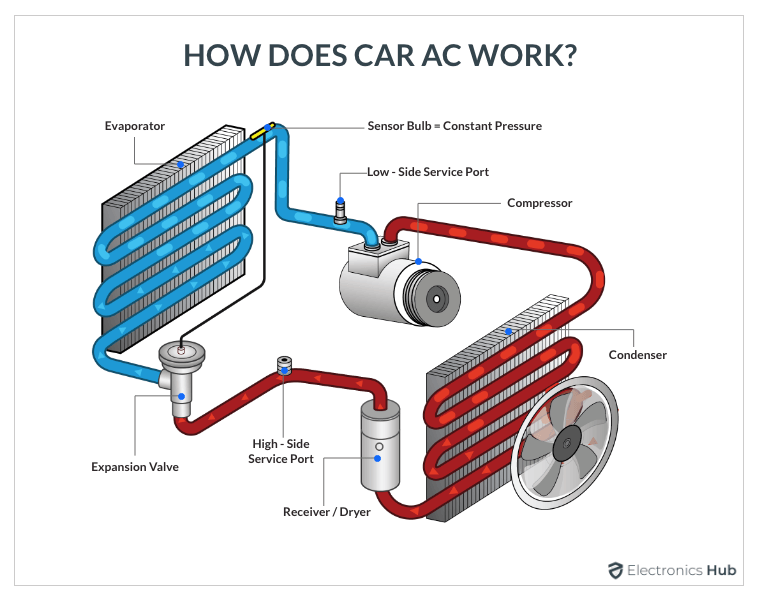
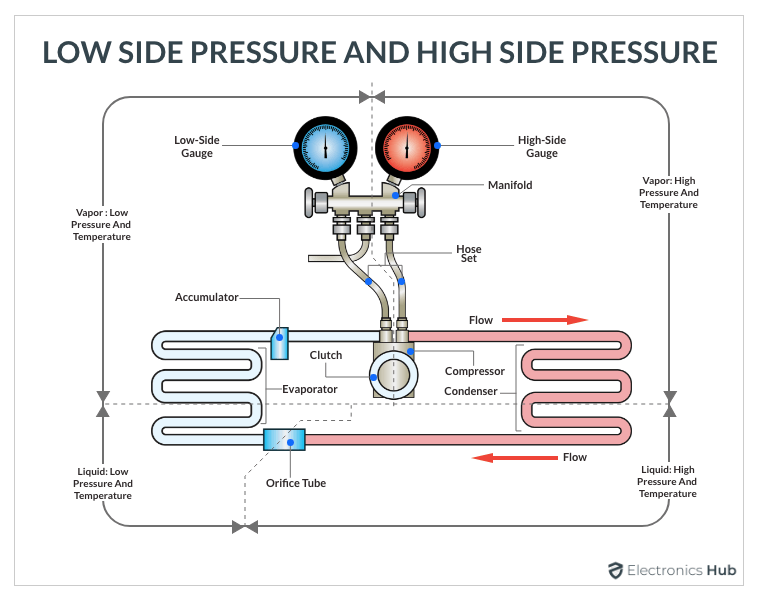
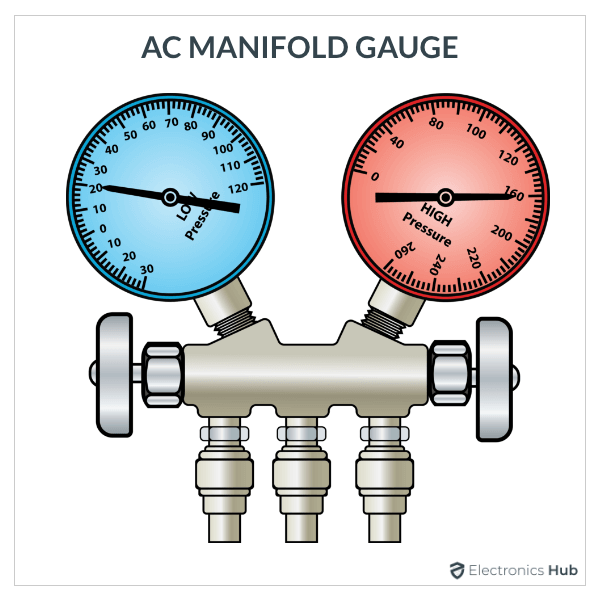
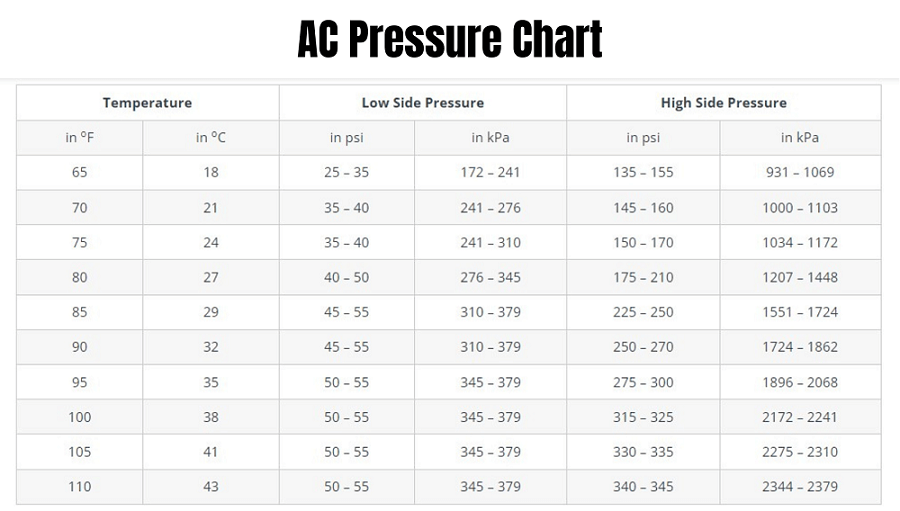
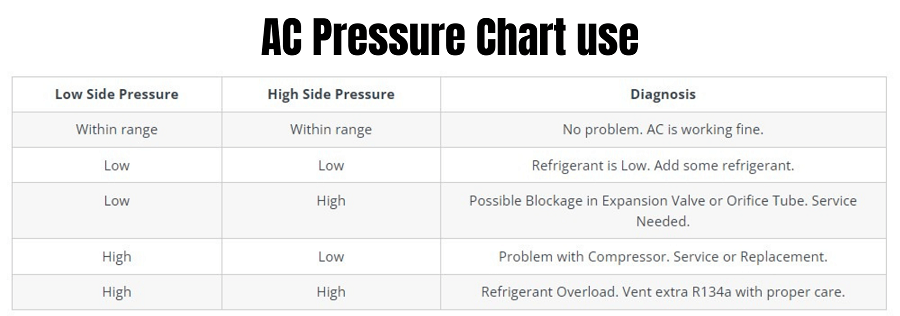

7 Responses
Informative. Very good
Relevant and informative article. Might I use excerpts in my training manual.
Thank you.
Excellent info to understand how auto AC works.
Very educative.
I do hope the pressure chat works in same manner as in temperate regions.
I’m refrigeration man,so I request for the best way of leak detection
At 62 years old I sometimes need to refresh myself with the ac system. Your explanation and charts are very simple and to the point.
Very much appreciated that someone is there to help us out !! Arizona! It’s a must have.
Good explanation about vehicle refrigerant system knowledge. Thanks a lot.